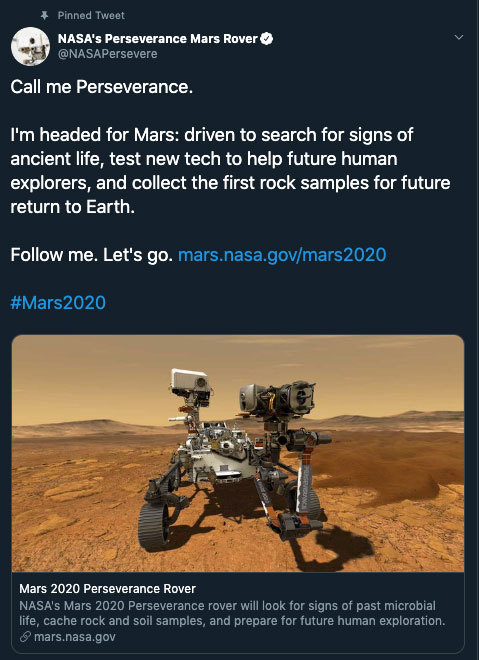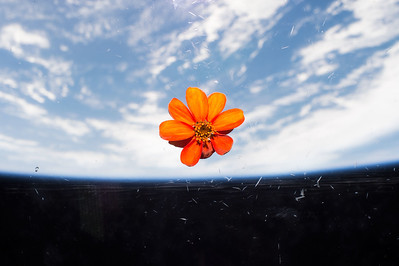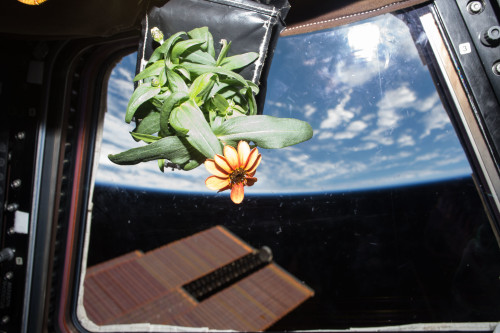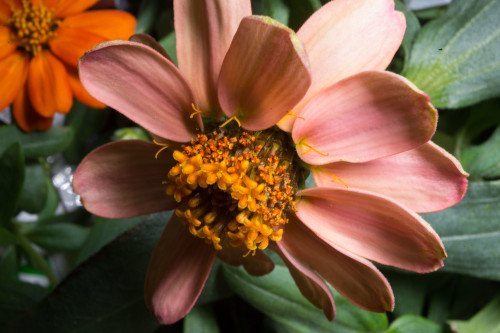300 Consecutive Days In Space!
300 Consecutive Days in Space!
Today marks astronaut Scott Kelly’s 300th day in space! He, along with Russian cosmonaut Mikhail Kornienko, are testing the limits of human research during their one-year mission onboard the International Space Station.

While most expeditions to the space station last four to six months, their time on orbit has been doubled. By increasing the length of their time in space, researchers hope to better understand how the human body reacts and adapts to long-duration spaceflight.
What happens when you’ve been in space for 300 days?
1. You might get bored and play ping pong with yourself…and a water droplet.

2. There’s a chance that you’ll get a Tweet from someone famous…like the President!

3. There may come a time where you’ll have to fix something outside the station during a spacewalk.

4. You might develop a ‘green thumb’ and grow plants in space.

5. And, there’s no doubt you get to see the Earth from a totally new perspective.

To learn more about the one-year mission, visit: https://www.nasa.gov/1ym
Make sure to follow us on Tumblr for your regular dose of space: http://nasa.tumblr.com
More Posts from Nasa and Others
The Adventures of Commander Moonikin Campos
Artemis I will be an enormous step toward humanity’s return to the Moon. This mission will be the first flight test of the integrated Space Launch System rocket and the Orion spacecraft — the same system that will send future Artemis astronauts to the Moon. That’s why NASA needs someone capable to test the vehicle. Someone with the necessary experience. Someone with the Right Stuff. (Or... stuffing).

Meet Commander Moonikin Campos. He is a manikin, or a replica human body. Campos is named after Arturo Campos, a trailblazing NASA employee who worked on Apollo missions. Arturo Campos’ skill as an electrical engineer was pivotal in the rescue efforts to help guide the Apollo 13 astronauts home.

As the leader of the mission, Commander Campos will be flying in the pilot’s seat for the length of the mission: a journey of 1.3 million miles (~2 million km) around the Moon and back to Earth. He's spent years training for this mission and he loves a challenge. Campos will be equipped with two radiation sensors and will have additional sensors under his headrest and behind his seat to record acceleration and vibration data throughout the mission.

Traveling with Campos are his quirky companions, Zohar and Helga. They’re part of a special experiment to measure radiation outside of the protective bubble of Earth’s atmosphere. Together with their commander, they’re excited to play a role in humanity’s next great leap. (And hopefully they can last the entire flight without getting on each other's nerves.)

Will our brave explorers succeed on their mission and ensure the success of future Artemis operations? Can Commander Moonikin Campos live up to the legacy of his heroic namesake?? And did anyone remember to bring snacks??? Get the answers in this thrilling three-part series!

In the first part of Commander Moonikin Campos’ journey, our trailblazing hero prepares for liftoff from NASA’s spaceport at Kennedy Space Center in Florida, gets acquainted with the new hardware aboard the Orion spacecraft, and meets his crewmates: Helga and Zohar!

In the second part of the trio’s adventure, Campos, Helga, and Zohar blast out of the Earth’s atmosphere with nearly 8.8 million pounds (4 million kg) of thrust powering their ascent. Next stop: the Moon!

In the final chapter of the Artemis I mission, Campos and friends prepare for their return home, including the last and most dangerous part of their journey: reentering Earth’s atmosphere at a screeching 25,000 miles per hour (40,000 kph).
Make sure to follow us on Tumblr for your regular dose of space!
Flooding Along the Mississippi
Rain, snowmelt, and soil moisture—those three factors might push portions of the Upper Mississippi River into major flooding this spring. Meanwhile, the middle and lower reaches of the river are already well out of their banks.
Intense storms over February 22-24, 2019, caused major flooding along the Middle Mississippi River. On February 25, 2019, the Landsat 8 satellite acquired images of swollen portions of the Mississippi River. The video above shows a false-color view of flooding near Memphis, Tennessee comparing February 2019 to February 2014. Flood waters appear blue; vegetation is green; and bare ground is brown. Notice how the Ohio River and Mississippi River have swelled near Cairo, the southernmost city in Illinois.
National Weather Service forecasters noted that higher-than-average precipitation in autumn 2018 saturated soils in the region, so additional rain or snowmelt from this winter will likely result in excessive runoff and increased flooding threats.
Rapid snowmelt will also play a role in flooding this spring in the Midwest. Parts of Minnesota and Wisconsin have built up snowpack of nearly 25 inches, so melting snow alone could propel many areas into major flooding.
Read the full story here.
Make sure to follow us on Tumblr for your regular dose of space: http://nasa.tumblr.com

Of course Saturn brought its ring light.
On June 25, 2023, our James Webb Space Telescope made its first near-infrared observations of Saturn. The planet itself appears extremely dark at this infrared wavelength, since methane gas absorbs almost all the sunlight falling on the atmosphere. The icy rings, however, stay relatively bright, leading to Saturn’s unusual appearance in this image.
This new image of Saturn clearly shows details within the planet’s ring system, several of the planet’s moons (Dione, Enceladus, and Tethys), and even Saturn’s atmosphere in surprising and unexpected detail.
These observations from Webb are just a hint at what this observatory will add to Saturn’s story in the coming years as the science team delves deep into the data to prepare peer-reviewed results.
Download the full-resolution image, both labeled and unlabeled, from the Space Telescope Science Institute.
Make sure to follow us on Tumblr for your regular dose of space!
Solar System: Things to Know This Week
Making every night science movie night with these amazing videos.

1. Pure Beauty
Our star sprouting coronal loops courtesy of the NASA sun team. See the full video: https://go.nasa.gov/2p47Lt2

2. Where’s the last place you'd expect to find enough ice to bury a city?
Answer: Mercury, the closest planet to the sun. Watch the video: https://svs.gsfc.nasa.gov/11184

3. The Mars Fleet
Only Earth has more satellites studying it. Full video: https://svs.gsfc.nasa.gov/4414

4. A Star-Studded Cast
Check out NASA's satellite fleet of Earth observers. See the video: https://svs.gsfc.nasa.gov/12586

5. Jupiter in Ultra HD
Thanks, Hubble Space Telescope! See the video: https://svs.gsfc.nasa.gov/12021

6. A Tear Jerker
Our Cassini spacecraft starts her 4.5-month Grand Finale this week. Full video: https://saturn.jpl.nasa.gov/resources/7628

7. Faster Than the Speed of Sound
Winds on Neptune travel faster than the speed of sound. Full video: https://svs.gsfc.nasa.gov/11349

8. A Musical Number
This one features the planet Uranus doing pop and lock. Full video: https://youtu.be/CWuWoiHmXUs

9. Up Close and Personal
Thanks to our New Horizons mission, we’ve been able to get up close and with Pluto. Full video: https://svs.gsfc.nasa.gov/12080

10: The Treasure Trove
TRAPPIST-1 is a treasure trove of seven Earth-sized planets orbiting a distant star. Full video: https://www.jpl.nasa.gov/video/details.php?id=1459
Discover more lists of 10 things to know about our solar system HERE.
Make sure to follow us on Tumblr for your regular dose of space: http://nasa.tumblr.com

Allow us to reintroduce someone ... the name’s Perseverance.
With this new name, our Mars 2020 rover has now come to life! Chosen by middle school student Alex Mather, Perseverance helps to remind ourselves that no matter what obstacles we face, whether it's on the way to reaching our goals or on the way to Mars, we will push through. In Alex’s own words,
“We are a species of explorers, and we will meet many setbacks on the way to Mars. However, we can persevere. We, not as a nation but as humans, will not give up. The human race will always persevere into the future.”
Welcome to the family. ❤️
Make sure to follow us on Tumblr for your regular dose of space: http://nasa.tumblr.com.
How to Connect with NASA
We're the nation’s space agency, but that doesn’t mean you have to travel to the depths of the universe to stay connected with the awesome stuff we’re doing. There are actually some really easy ways to stay updated on all things space. Check them out:
Apps

We have lots of apps for smartphones and tablets that will make it easier than ever to stay connected to space. Here are a few to pique your interest:
NASA App: Showcases a huge collection of the latest content, including images, videos, mission information, stories, space station sighting opportunities and more! Download: Apple/Android
NASA Spinoff App: This application profiles the best examples of technology that have been transferred from NASA research and missions into commercial products. From life-saving satellite systems to hospital robots, our technologies benefit society. Download: Apple
NASA 3DV App: The 3DV mobile app allows you to examine several of our Deep Space Exploration projects that will take our space program to asteroids, Mars and beyond! Download: Apple/Android
Spacecraft 3D: This augmented reality (AR) application lets you learn about and interact with a variety of spacecraft that are used to explore our solar system, study Earth and observe the universe. Download: Apple/Android
Competitions and Challenges

NASA Solve is an invitation to members of the public to contribute their time and expertise to solving problems and potentially winning prizes as a result of their work. This is a great way for individual members of the public to be a part of the nation’s space program. For a complete list of current challenges and competitions, visit THIS page.
Citizen Science
You don’t have to be a NASA employee to engage in the fun of interpreting scientific data and imagery from our many spacecraft and missions. As part of our Open Government plan, our goal is to promote transparency, participation and collaboration. By expanding the research base and using open innovation, we are all able to benefit from the accumulated findings. You can find data from our missions, research and activities HERE.
Email and Social Media
We have a wide-range of social media accounts here at NASA. Everything from Earth Science to the Mars Curiosity Rover, you can stay updated on many of our missions on many popular social media sites. For a full list of our accounts, visit THIS page.
If you’d like to get space news delivered straight to your inbox, you can sign up for updates and manage preferences HERE.
NASA Socials

What is a NASA Social? We’re glad you asked! These programs provide opportunities for our social media followers to learn and share information about our missions, people and programs. NASA Social includes both special in-person events and social media credentials for individuals who share the news in a significant way. Social events provide the participants with the opportunity to go behind-the-scenes at our facilities and events and speak with scientists engineers, astronauts and managers. Visit THIS page for a list of upcoming NASA Social opportunities.
Make sure to follow us on Tumblr for your regular dose of space: http://nasa.tumblr.com
We Just Identified More Than 200 New (Potential) Planets
The Kepler space telescope is our first mission capable of identifying Earth-size planets around other stars. On Monday, June 19, 2017, scientists from many countries gathered at our Ames Research Center to talk about the latest results from the spacecraft, which include the identification of more than 200 potential new worlds! Here’s what you need to know:
We found 219 new planet candidates.

All of these worlds were found in a patch of sky near the Cygnus constellation in our Milky Way galaxy. Between 2009 and 2013, Kepler searched more than 200,000 stars in the region for orbiting planets. The 219 new planet candidates are part of the more than 4,000 planet candidates and 2,300 confirmed planets Kepler has identified to date.
Ten of these worlds are like our own.

Out of the 219 new planet candidates, 10 are possibly rocky, terrestrial worlds and orbit their star in the habitable zone – the range of distances from a star where liquid water could pool on the surface of a rocky planet.
Small planets come in two sizes.

Kepler has opened up our eyes to the existence of many small worlds. It turns out a lot of these planets are either approximately 1.5 times the size of Earth or just smaller than Neptune. The cool names given to planets of these sizes? Super Earths and mini-Neptunes.
Some of the new planets could be habitable.

Water is a key ingredient to life as we know it. Many of the new planet candidates are likely to have small rocky cores enveloped by a thick atmosphere of hydrogen and helium, and some are thought to be ocean worlds. That doesn’t necessarily mean the oceans of these planets are full of water, but we can dream, can’t we?
Other Earths are out there.

Kepler’s survey has made it possible for us to measure the number of Earth-size habitable zone planets in our galaxy. Determining how many planets like our own that exist is the big question we’ll explore next.
The hunt for new planets continues.

Kepler continues to search for planets in different regions of space. With the launch of our Transiting Exoplanet Survey Satellite (TESS) and the James Webb Space Telescope (JWST) in 2018, we’re going to search for planets nearest the sun and measure the composition of their atmospheres. In the mid-2020s, we have our sights on taking a picture of small planets like Earth with our Wide-Field Infrared Survey Telescope (WFIRST).
*All images of planets are artist illustrations.
Make sure to follow us on Tumblr for your regular dose of space: http://nasa.tumblr.com
Colors of Earth
When we think of our globe from a distance, we generally visualize two colors: blue and green. Water and land. Mostly water, consequently, our planet’s nickname of the blue marble.
Traveling around the globe every 90 minutes covering millions of miles with a focused lens on our beautiful planet from 250 miles above, I’ve captured many beautiful colors beyond blue and green that showcase Earth in new and interesting ways. Some colors are indicative of nature like desert sands and weather like snow. Other colors tell stories of Earth’s climate in bright splashes of yellows and greens of pollen and muted grey tones and clouded filters of pollution.
Blue and green still remain vivid and beautiful colors on Earth from the vantage point of the International Space Station, but here are some other colors that have caught my eye from my orbital perspective.

African violet

Bahamas blues

Tropical in Africa

Yellow desert

Orange in Egypt

Red surprise

Snow white
Follow my Year In Space on Twitter, Facebook and Instagram!



Take a moment, look outside your window. 🌷🌼
Today is the #FirstDayOfSpring in the Northern Hemisphere, also known as the vernal equinox.
#DYK Earth’s tilted axis causes the season? Throughout the year, different parts of Earth receive the Sun’s most direct rays. So, when the North Pole tilts toward the Sun, it’s summer in the Northern Hemisphere. And when the South Pole tilts toward the Sun, it’s winter in the Northern Hemisphere.
These images are of Zinnias. They are part of the flowering crop experiment that began aboard the International Space Station on Nov. 16, 2015, when NASA astronaut Kjell Lindgren activated the Veggie system and its rooting "pillows" containing zinnia seeds.
Make sure to follow us on Tumblr for your regular dose of space: http://nasa.tumblr.com.
What is the best and worst thing about being in a zero gravity environment?
-
 astrogusta-blog reblogged this · 8 years ago
astrogusta-blog reblogged this · 8 years ago -
 mygardenofedenn liked this · 8 years ago
mygardenofedenn liked this · 8 years ago -
 azyaxxi-blog reblogged this · 9 years ago
azyaxxi-blog reblogged this · 9 years ago -
 azyaxxi-blog liked this · 9 years ago
azyaxxi-blog liked this · 9 years ago -
 1d-my-stereo-heart liked this · 9 years ago
1d-my-stereo-heart liked this · 9 years ago -
 galaxxy-ocean liked this · 9 years ago
galaxxy-ocean liked this · 9 years ago -
 kateuba liked this · 9 years ago
kateuba liked this · 9 years ago -
 ladykatuko reblogged this · 9 years ago
ladykatuko reblogged this · 9 years ago -
 andthatshowtomdied liked this · 9 years ago
andthatshowtomdied liked this · 9 years ago -
 gwathdring reblogged this · 9 years ago
gwathdring reblogged this · 9 years ago -
 gwathdring liked this · 9 years ago
gwathdring liked this · 9 years ago -
 aboxthecolourofheartache reblogged this · 9 years ago
aboxthecolourofheartache reblogged this · 9 years ago -
 celesitti-blog liked this · 9 years ago
celesitti-blog liked this · 9 years ago -
 vip3rpilot liked this · 9 years ago
vip3rpilot liked this · 9 years ago -
 bananaleighjohns liked this · 9 years ago
bananaleighjohns liked this · 9 years ago -
 sabahk1997 liked this · 9 years ago
sabahk1997 liked this · 9 years ago -
 alucard1979 liked this · 9 years ago
alucard1979 liked this · 9 years ago -
 alwaze-hy liked this · 9 years ago
alwaze-hy liked this · 9 years ago -
 7fifty4pm liked this · 9 years ago
7fifty4pm liked this · 9 years ago -
 dyngenights liked this · 9 years ago
dyngenights liked this · 9 years ago -
 berrkkkkkkkkkk-blog liked this · 9 years ago
berrkkkkkkkkkk-blog liked this · 9 years ago -
 ponderingruthlessly reblogged this · 9 years ago
ponderingruthlessly reblogged this · 9 years ago -
 ponderingruthlessly liked this · 9 years ago
ponderingruthlessly liked this · 9 years ago -
 falloutmychemicalwatson-blog reblogged this · 9 years ago
falloutmychemicalwatson-blog reblogged this · 9 years ago -
 falloutmychemicalwatson-blog liked this · 9 years ago
falloutmychemicalwatson-blog liked this · 9 years ago -
 icumfrom-space liked this · 9 years ago
icumfrom-space liked this · 9 years ago -
 bewhereyourfeetare liked this · 9 years ago
bewhereyourfeetare liked this · 9 years ago -
 mrsioana reblogged this · 9 years ago
mrsioana reblogged this · 9 years ago -
 bigmeckle-blog reblogged this · 9 years ago
bigmeckle-blog reblogged this · 9 years ago -
 llyrehc13-blog liked this · 9 years ago
llyrehc13-blog liked this · 9 years ago -
 countingdiamonds reblogged this · 9 years ago
countingdiamonds reblogged this · 9 years ago -
 emeksr liked this · 9 years ago
emeksr liked this · 9 years ago -
 halsterone liked this · 9 years ago
halsterone liked this · 9 years ago -
 c4shley-777 reblogged this · 9 years ago
c4shley-777 reblogged this · 9 years ago -
 headspacedeficit reblogged this · 9 years ago
headspacedeficit reblogged this · 9 years ago -
 headspacedeficit liked this · 9 years ago
headspacedeficit liked this · 9 years ago -
 nethos135 liked this · 9 years ago
nethos135 liked this · 9 years ago -
 swiggity-swag-im-a-stag reblogged this · 9 years ago
swiggity-swag-im-a-stag reblogged this · 9 years ago -
 swiggity-swag-im-a-stag liked this · 9 years ago
swiggity-swag-im-a-stag liked this · 9 years ago -
 liptonicedpee liked this · 9 years ago
liptonicedpee liked this · 9 years ago
Explore the universe and discover our home planet with the official NASA Tumblr account
1K posts